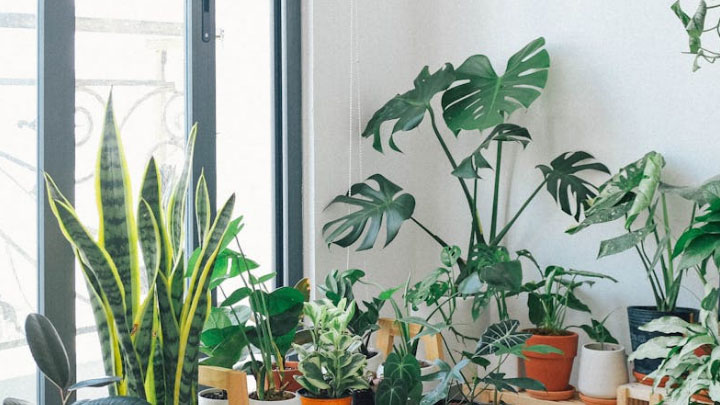The Best Indoor Plants to Help Clean the Air
Indoor air quality is a growing concern, especially as we spend more time indoors. With pollutants like formaldehyde, benzene, and trichloroethylene lurking in our homes, finding ways to purify the air is essential. One natural and aesthetically pleasing solution is incorporating air-purifying plants into your living space. These indoor plants not only add a touch of greenery to your home but also help filter out harmful toxins, improving the overall air quality. Here are some of the best indoor plants that can help clean the air in your home.
- Spider Plant (Chlorophytum comosum)
The spider plant is a resilient and easy-to-care-for houseplant known for its air-purifying abilities. It effectively removes common indoor pollutants like formaldehyde, xylene, and carbon monoxide from the air. The spider plant is also non-toxic, making it a safe choice for homes with pets or small children. Its long, arching leaves and ability to produce “babies” (small offshoots) make it a charming addition to any room.
Care Tips: Spider plants thrive in indirect sunlight and prefer to be kept in well-draining soil. They require regular watering but can tolerate occasional neglect.
- Snake Plant (Sansevieria trifasciata)
Also known as “mother-in-law’s tongue,” the snake plant is one of the most effective air-purifying plants. It excels at removing toxins like formaldehyde, benzene, xylene, and toluene from the air. What makes the snake plant particularly special is its ability to perform photosynthesis at night, releasing oxygen while you sleep. This makes it an excellent choice for bedrooms.
Care Tips: Snake plants are incredibly low-maintenance. They can tolerate low light levels and infrequent watering, making them perfect for beginners or those with busy lifestyles.
- Peace Lily (Spathiphyllum)
The peace lily is not only beautiful with its dark green leaves and white blooms, but it’s also a powerful air purifier. It’s known for removing a variety of toxins, including ammonia, formaldehyde, benzene, and trichloroethylene. The peace lily also helps to increase indoor humidity levels, which can be beneficial for people with respiratory issues.
Care Tips: Peace lilies prefer medium to low light and thrive in humid conditions. Keep the soil consistently moist but avoid overwatering, as this can lead to root rot.
- Aloe Vera
Aloe vera is widely known for its healing properties, but it’s also an excellent air-purifying plant. It’s particularly effective at removing formaldehyde and benzene, which are common in household cleaning products. Aloe vera is a succulent, so it stores water in its leaves and doesn’t require frequent watering.
Care Tips: Aloe vera thrives in bright, indirect sunlight. Water it sparingly, allowing the soil to dry out completely between waterings.
- Boston Fern (Nephrolepis exaltata)
Boston ferns are lush, attractive plants that are excellent at removing formaldehyde and xylene from the air. They also act as natural humidifiers, making them ideal for rooms with dry air. While they do require a bit more care than some other plants, their air-purifying abilities and beautiful appearance make them well worth the effort.
Care Tips: Boston ferns prefer indirect light and high humidity. Keep the soil consistently moist and mist the leaves regularly to maintain humidity.
- English Ivy (Hedera helix)
English ivy is a versatile and hardy plant that’s great at reducing airborne fecal particles, mold, and formaldehyde in your home. Its ability to remove mold spores from the air makes it an excellent choice for bathrooms or damp areas. English ivy can be grown in hanging baskets, as a ground cover, or trained to climb up trellises, making it a versatile addition to any space.
Care Tips: English ivy prefers indirect light and regular watering. Ensure the soil is well-draining, and mist the leaves regularly to keep them hydrated.
- Bamboo Palm (Chamaedorea seifrizii)
The bamboo palm is a popular indoor plant known for its tall, graceful fronds. It’s particularly effective at filtering out formaldehyde, benzene, and trichloroethylene, making it a great addition to living rooms and offices. The bamboo palm also helps to add moisture to the air, which can be beneficial in dry climates or during winter.
Care Tips: Bamboo palms prefer bright, indirect light and high humidity. Water regularly, keeping the soil moist but not waterlogged.
- Golden Pothos (Epipremnum aureum)
Golden pothos, also known as devil’s ivy, is one of the most resilient indoor plants. It’s known for its ability to remove formaldehyde, benzene, and xylene from the air. Its trailing vines make it a great choice for hanging baskets or shelves, where its vibrant green and yellow leaves can cascade beautifully.
Care Tips: Golden pothos thrives in a variety of lighting conditions, from low to bright indirect light. It’s also forgiving when it comes to watering, tolerating dry soil between waterings.
- Dracaena (Dracaena spp.)
Dracaenas are a group of houseplants known for their long, arching leaves and air-purifying abilities. They’re particularly effective at removing formaldehyde, benzene, trichloroethylene, and xylene from the air. Dracaenas come in various shapes, sizes, and colors, making them a versatile option for any room.
Care Tips: Dracaenas prefer bright, indirect light but can tolerate lower light levels. Keep the soil lightly moist and be careful not to overwater, as they’re sensitive to excess moisture.
- Rubber Plant (Ficus elastica)
The rubber plant is a striking houseplant with large, glossy leaves that can help remove toxins like formaldehyde from the air. Its broad leaves are also efficient at absorbing carbon dioxide and converting it into oxygen, making it an excellent plant for improving indoor air quality.
Care Tips: Rubber plants prefer bright, indirect light and moderate watering. Allow the top inch of soil to dry out between waterings, and wipe the leaves occasionally to keep them dust-free.
Conclusion
Incorporating air-purifying plants into your home is a natural and effective way to improve indoor air quality. Not only do these plants help remove harmful toxins, but they also add beauty and tranquility to your living space. Whether you’re a seasoned plant enthusiast or a beginner, there’s an air-purifying plant that will suit your home and lifestyle. By choosing the right plants and providing them with proper care, you can create a healthier, fresher indoor environment for you and your family.

